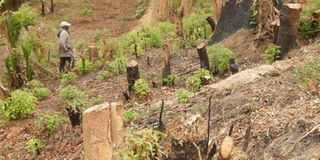Seven-point route to saving our forests

This image taken on February 28, 2018 shows the effects of logging in Wundanyi forest, Taita Taveta County. PHOTO | LUCY MKANYIKA | NATION MEDIA GROUP
What you need to know:
- Everyone bordering a forest should take up the policing of forest chunks that are adjacent to them.
- Everyone should do their bit in the re-establishment of Kenya’s forest cover. No one can afford to be an interloper in this.
Kenya’s forest cover has receded so much that only 10 per cent or less of Kenya’s total land area has trees.
Kenya’s five main forests – Mt Kenya, the Aberdare ranges, the Mau complex, Mt Elgon and the Cherangani hills – are all facing a deforestation menace that cannot be solved by stopgap measures such as the government banning logging for three months.
An example of an acute deforestation case is the Embobut forest situation.
Embobut forest is a part of the Cherangani water tower that forms a large section of the upland plateau of Marakwet.
It is a natural forest whose area is gazetted to be about 22,000 hectares.
DROUGHT
Presently, the forest is diminishing on every side and from within its heart.
Illegal loggers, charcoal burners, illegal settlers, grazers, ignorance on the overall importance of the forest and the perception that the forest belongs to the government and not the people, especially after the recent forceful evictions of squatters from the forest, are to blame for the state of affairs.
Deforestation in the Embobut forest and other forests excites a spate of environmental hazards and disasters which include: Drying up of rivers and streams, enhanced soil erosion, siltation of rivers and dams, floods, scenic pollution, aridity and drought, climate change and food shortage.
These environmental problems negatively affect the lives and livelihoods of Kenyans.
CIVIC EDUCATION
While acknowledging the rigorous attempts by the government to bridle deforestation in Kenya, more needs to be done.
This would entail: 1. Inculcating some pride in forest ownership and forest protection among the people.
Everyone bordering a forest should take up the policing of forest chunks that are adjacent to them.
The forest department should then assist in the restoration of the chunks chosen, which will be left to the forest neighbour to tend and protect. This calls for gallant civic education.
TREE PLANTING
2. Encouraging robust carbon trading in forestry by paying tree farmers for the amount of carbon that they help sink.
3. Urgent afforestation and reforestation of all natural forests and their buffer zones by the people and the government.
It is strongly suggested that native trees be used and elders be consulted on where they grew natively.
Locals can also be engaged to develop nurseries for the trees as a commercial venture.
4. Strengthening of Kenya’s forest policies to make them more functional and effective.
Consequently, brisk measures should be put in place to ensure the implementation of these policies.
5. Motivating land owners to set up wood lots and plant cover crops.
6. Reinvigorating the paper industry in Kenya so that tree farming can be established as a business in the country.
7. Vanquishing every form of “The Tragedy of the Commons” in the use of forest resources, so that people stop acting selfishly.
8. Finally, everyone should do their bit in the re-establishment of Kenya’s forest cover. No one can afford to be an interloper in this. We can reforest Kenya, one tree a time.
Dr Kipkiror is an environmental consultant and a lecturer at the University of Kabianga. Email: [email protected].





